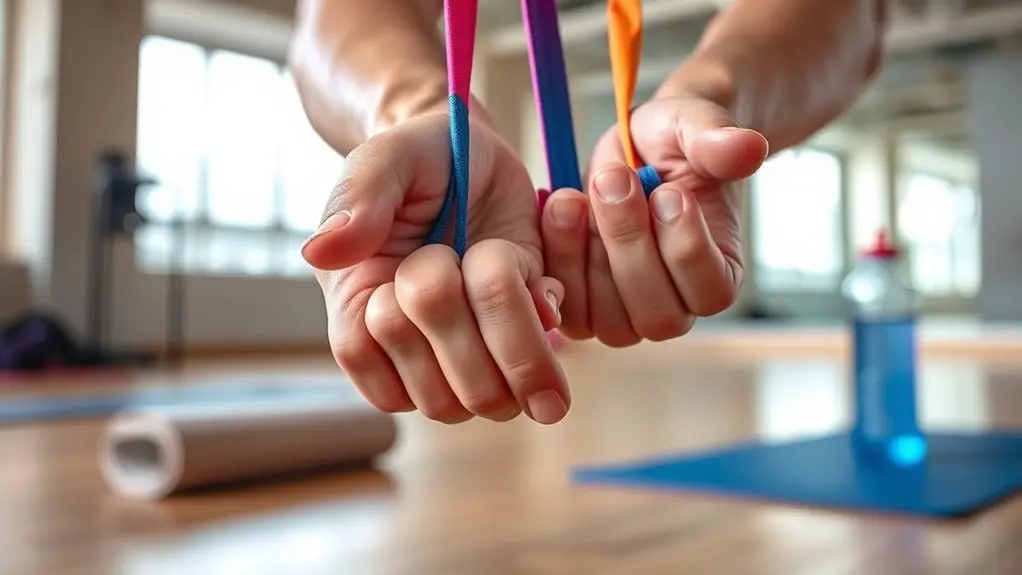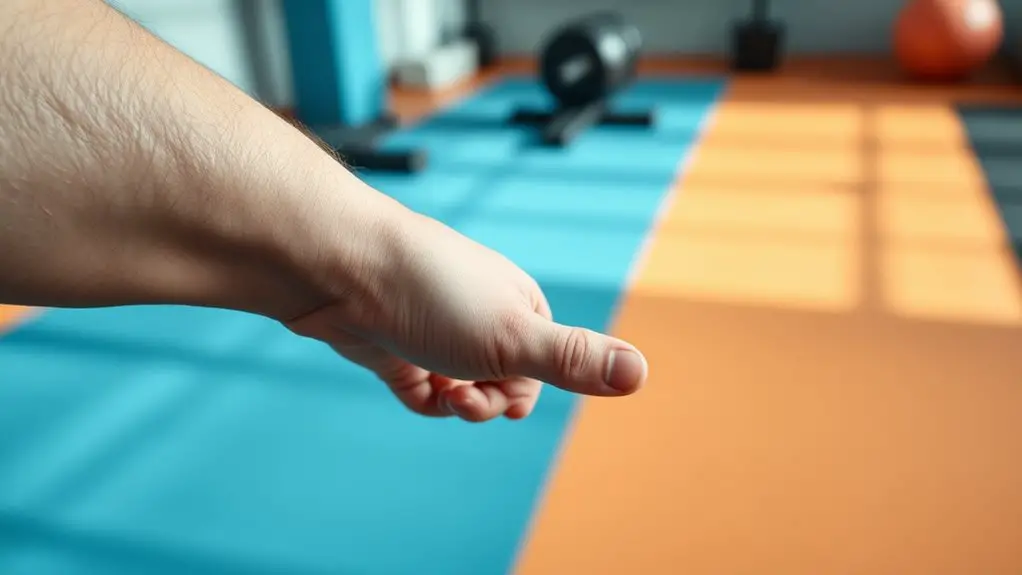The Best Gym Exercises to Prevent Carpal Tunnel Syndrome

To prevent carpal tunnel syndrome, focus on exercises that strengthen your wrists and forearms. Incorporate warm-up exercises like wrist rotations and finger flexes. Add dynamic movements such as dumbbell wrist curls and resistance band exercises for flexibility and stability. Don’t forget the importance of stretching with wrist flexor and extensor stretches. You’ll also benefit from core stability exercises like forearm planks. With consistent practice, you can enhance your hand health and avoid discomfort—keep exploring to find more tips!
Understanding Carpal Tunnel Syndrome

Carpal Tunnel Syndrome (CTS) is a condition that arises when the median nerve, which runs through the wrist, becomes compressed. You might experience this due to various causes, such as repetitive wrist movements, inflammation, or certain health conditions like diabetes and arthritis. It’s vital to be aware of the symptoms carpal tunnel can present, including tingling, numbness, or pain in your fingers and wrist. These sensations often worsen at night or after extended activities like typing or lifting. If you notice these signs, it’s important to take them seriously, as ignoring them can lead to chronic pain or weakness. To prevent CTS, focus on maintaining proper wrist posture and taking regular breaks during repetitive tasks. By understanding the causes and symptoms of carpal tunnel syndrome, you can take proactive steps to protect your wrists and guarantee a safer experience in your daily activities.
Importance of Wrist and Forearm Strength
Having strong wrists and forearms is vital for improving your grip strength and overall stability. When these areas are well-conditioned, you’re not just enhancing your performance but also reducing the risk of injuries. Let’s explore why focusing on wrist and forearm strength is imperative for your fitness routine.
Improves Grip Strength
Building wrist and forearm strength isn’t just about lifting heavier weights; it’s crucial for improving grip strength, which plays an important role in preventing injuries like carpal tunnel syndrome. When you engage in grip training, you’re not only enhancing your performance in various activities but also safeguarding your wrists and hands from strain. Incorporating hand exercises into your routine, like wrist curls or hand grippers, can greatly boost your grip strength. These exercises help strengthen the muscles that support your wrists, making them more resilient against repetitive stress. By prioritizing grip strength, you’re taking proactive steps to guarantee your safety and well-being during workouts and daily tasks, ultimately reducing the risk of developing carpal tunnel syndrome.
Enhances Overall Stability
Strengthening your wrists and forearms can greatly enhance your overall stability, which is essential for a well-rounded fitness routine. When you focus on developing these muscles, you’re not just improving grip strength; you’re also supporting your core stability. A stable core is crucial for maintaining proper posture and balance during various exercises. Incorporating balance training into your workouts can further aid in this process, as it challenges your body to engage your wrists and forearms effectively. By enhancing stability in these areas, you’ll find it easier to perform a range of movements safely and efficiently. So, don’t overlook wrist and forearm strength; it’s a key element in achieving better overall fitness and performance.
Reduces Injury Risk
Since your wrists and forearms play an essential role in various physical activities, neglecting their strength can greatly increase your risk of injury. Strengthening these areas is an effective prevention strategy against common issues like carpal tunnel syndrome. When your wrists and forearms are strong, they can better support your movements, reducing strain during exercises and daily tasks. This not only enhances your performance but also plays an important role in injury management. By incorporating targeted exercises into your routine, you’ll build resilience and flexibility, making it easier to avoid overuse injuries. Remember, prioritizing wrist and forearm strength is a smart step toward maintaining overall safety and well-being in your fitness journey. Stay proactive, and keep your body safe!
Warm-Up Exercises for Hand and Wrist Health
Before diving into your workout, incorporating warm-up exercises specifically designed for your hands and wrists can markedly enhance your overall performance and reduce the risk of injuries like carpal tunnel syndrome. Focusing on hand mobility and wrist rotation is essential for preparing these areas for more intense activity.
Here’s a simple warm-up routine to get you started:
| Exercise | Duration | Benefits |
|---|---|---|
| Wrist Rotations | 1 minute | Improves wrist flexibility |
| Finger Flexes | 1 minute | Enhances hand mobility |
| Palm Presses | 1 minute | Strengthens grip |
| Thumb Stretch | 1 minute | Increases thumb flexibility |
| Hand Shakes | 1 minute | Relaxes hand muscles |
Wrist Flexor Stretch

One effective way to alleviate tension in your wrists and prevent carpal tunnel syndrome is through the wrist flexor stretch. This simple exercise enhances wrist mobility and promotes hand flexibility, making it essential for those who spend long hours typing or using their hands. To perform the stretch, extend one arm in front of you with your palm facing up. Use your other hand to gently pull back on your fingers, feeling a mild stretch in your forearm. Hold this position for about 15-30 seconds, then switch to the other hand.
Remember to breathe deeply and avoid any pain during the stretch. Consistency is key; aim to incorporate this stretch into your daily routine. Not only will it help maintain flexibility, but it’ll also reduce the risk of discomfort and injury. By prioritizing your wrist health, you can keep enjoying your favorite activities without worry.
Wrist Extensor Stretch
Now that you’ve stretched your wrist flexors, it’s time to focus on the wrist extensors. Stretching these muscles is essential for maintaining flexibility and preventing strain that can lead to carpal tunnel issues. Let’s go over how to perform the wrist extensor stretch effectively.
Importance of Stretching
Stretching plays an essential role in preventing carpal tunnel syndrome, especially with exercises like the wrist extensor stretch. By incorporating this stretch into your routine, you enhance dynamic flexibility, allowing your wrists to move freely and comfortably. Improved flexibility helps reduce tension in the muscles, which can alleviate pressure on the median nerve, a key factor in carpal tunnel syndrome. Additionally, regular stretching promotes muscle recovery, ensuring your wrists are resilient and less prone to injury. It’s vital to prioritize these stretches, especially if you engage in activities that strain your wrists. Remember, a few minutes of stretching can make a significant difference in maintaining wrist health and preventing discomfort in the long run. Stay safe and stretch wisely!
How to Perform
To perform the wrist extensor stretch, start by extending one arm in front of you with your palm facing down. Use your opposite hand to gently pull back on your fingers, applying a light pressure. You should feel a stretch along the top of your forearm; hold this position for 15-30 seconds. Be careful not to overextend or force the stretch, as this could lead to discomfort. Repeat on the other side to guarantee balanced wrist mobility. Incorporating this stretch into your routine can help improve grip techniques and reduce the risk of carpal tunnel syndrome. Remember, consistency is key, so try to perform this stretch a few times a week for ideal results.
Forearm Plank

Although it may seem like a simple exercise, the forearm plank is an effective way to strengthen your core and improve wrist stability, which can help prevent carpal tunnel syndrome. When you hold this position, you engage multiple muscle groups, promoting overall stability and reducing strain on your wrists.
To maximize forearm plank benefits, try incorporating variations such as side planks or plank shoulder taps. These variations not only challenge your core but also keep your wrists in a neutral position, further enhancing wrist health.
Always verify your form is correct to avoid injury—keep your body in a straight line from head to heels, and don’t let your hips sag. Start with shorter durations and gradually increase your time as your strength improves. By integrating the forearm plank into your routine, you can build resilience against carpal tunnel syndrome while fortifying your core strength.
Dumbbell Wrist Curls
Building on the stability gained from exercises like the forearm plank, incorporating dumbbell wrist curls into your routine can further enhance wrist strength and flexibility. To perform this exercise safely and effectively, follow these tips:
- Choose the right weight: Start with lighter dumbbell variations to avoid strain.
- Use proper grip technique: Verify your grip is firm but relaxed to prevent tension in your hands.
- Position your arms correctly: Rest your forearms on a flat surface, allowing your wrists to hang off the edge.
- Control your movements: Lift and lower the weights slowly to maximize muscle engagement and minimize risk.
- Listen to your body: If you feel discomfort, stop and reassess your form or weight choice.
Incorporating dumbbell wrist curls into your workouts can promote wrist health and help prevent carpal tunnel syndrome effectively.
Resistance Band Exercises
Resistance band exercises are a fantastic way to strengthen your wrists and forearms while minimizing the risk of carpal tunnel syndrome. Using band resistance allows you to control the intensity and focus on proper form, ensuring a safe workout. Start with exercises like wrist flexion and extension. Secure the band under your foot or a stable surface, gripping the ends with your hands. Slowly flex and extend your wrists, feeling the gentle resistance throughout the movement.
Incorporate mobility training by adding rotations and lateral movements. These exercises not only strengthen the muscles but also improve joint flexibility, reducing the likelihood of stiffness. Aim for 2-3 sets of 10-15 repetitions, adjusting the band resistance as needed. Remember to listen to your body; if you feel any discomfort, stop and reassess your form. By consistently including resistance band exercises in your routine, you’ll actively help protect your wrists from carpal tunnel syndrome.
Incorporating Stretch Breaks Into Your Routine
Incorporating stretch breaks into your routine can make a significant difference in preventing carpal tunnel syndrome. By adding regular stretches, you can reduce tension and improve circulation in your arms and wrists. Aim for a stretch frequency of every hour, even if it’s just for a few minutes. Here are some effective stretches to evaluate during your break duration:
- Wrist flexor stretch: Extend your arm, palm up, and gently pull back on your fingers.
- Wrist extensor stretch: Extend your arm, palm down, and pull back on your fingers.
- Finger stretches: Spread your fingers wide and then bring them back together.
- Shoulder rolls: Roll your shoulders forward and backward to relieve tension.
- Neck stretches: Tilt your head to each side, gently stretching the neck muscles.
Frequently Asked Questions
Can Carpal Tunnel Syndrome Affect My Fingers and Hands Differently?
Yes, carpal tunnel syndrome can affect your fingers and hands differently. You might experience varying levels of finger mobility, making it difficult to perform tasks. Hand strength can also be impacted, leading to weakness or clumsiness. It’s crucial to pay attention to these changes, as they can affect daily activities. If you’re noticing symptoms, consider consulting a healthcare professional to discuss safe approaches for managing your condition and improving your overall hand function.
How Long Should I Hold Stretches for Best Results?
“Good things come to those who wait.” When it comes to stretching, holding each stretch for 15 to 30 seconds is ideal for best results. This stretch duration allows your muscles to relax and improve flexibility benefits without risking injury. Make sure you’re breathing deeply and not pushing too hard; safety is key. Consistent practice can lead to better range of motion and overall comfort in your hands and fingers.
Are There Specific Exercises for Desk Workers?
If you’re a desk worker, incorporating specific exercises can really help. Focus on wrist mobility to maintain flexibility and reduce strain. Simple stretches like wrist flexor and extensor stretches can be beneficial. Additionally, make sure to take into account ergonomic adjustments in your workspace, like proper chair height and keyboard position. These changes can alleviate pressure on your wrists and prevent discomfort. Remember, consistency is key to keeping your wrists healthy and pain-free!
What Lifestyle Changes Can Help Prevent Carpal Tunnel Syndrome?
Imagine a world where your wrists dance gracefully like a skilled pianist. To prevent carpal tunnel syndrome, consider making ergonomic adjustments to your workspace. Your chair and keyboard should support your posture, keeping your wrists straight. Don’t underestimate the power of wrist supports; they can offer comfort when typing. Take regular breaks to stretch and move around, allowing your wrists to breathe. With these changes, you’ll find safety and relief in your daily routine.
When Should I Consult a Healthcare Professional About My Symptoms?
If you’re experiencing symptoms like tingling, numbness, or pain in your hands or wrists, it’s important to consult a healthcare professional, especially if the symptom severity is increasing. Don’t wait too long; early intervention can lead to better healthcare options and prevent further issues. If your symptoms interfere with daily activities or persist despite self-care, seek guidance to guarantee you’re addressing the problem effectively and safely.





